托福2016年下半年阅读机经
2016年托福阅读模拟试题及答案解析(5)

Throughout the nineteenth century and into the twentieth, citizens of the United States maintained a bias against big cities. Most lived on farms and in small towns and believed cities to be centers of corruption, crime, poverty, and moral degradation. Their distrust was caused, in part, by a national ideology that proclaimed farming the greatest occupation and rural living superior to urban living. This attitude prevailed even as the number of urban dwellers increased and cities became an essential feature of the national landscape. Gradually, economic reality overcame ideology. Thousands abandoned the precarious life on the farm for more secure and better paying jobs in the city. But when these people migrated from the countryside, they carried their fears and suspicious with them. These new urbanities, already convinced that cities were overwhelmed with great problems, eagerly embraced the progressive reforms that promised to bring order out of the chaos of the city. One of many reforms came in the area of public utilities. Water and sewerage systems were usually operated by municipal governments, but the gas and electric networks were privately owned. Reformers feared that the privately owned utility companies would charge exorbitant rates for these essential services and deliver them only to people who could afford them. Some city and state governments responded by regulating the utility companies, but a number of cities began to supply these services themselves. Proponents of these reforms argued that public ownership and regulation would insure widespread access to these utilities and guarantee a fair price. While some reforms focused on government and public behavior, others looked at the cities as a whole. Civic leaders, convinced that physical environment influenced human behavior, argued that cities should develop master plans to guide their future growth and development. City planning was nothing new, but the rapid industrialization and urban growth of the late nineteenth century took place without any consideration for order. Urban renewal in the twentieth century followed several courses. Some cities introduced plans to completely rebuild the city core. Most other cities contented themselves with zoning plans for regulating future growth. Certain parts of town were restricted to residential use, while others were set aside for industrial or commercial development. 1. What does the passage mainly discuss? (A) A comparison of urban and rural life in the early twentieth century (B) The role of government in twentieth century urban renewal (C) Efforts to improve urban life in the early twentieth century (D) Methods of controlling urban growth in the twentieth century 2. The word "bias偏见" in line 2 is closest in meaning to (A) diagonal斜线的 (B) slope (C) distortion (D) prejudice 3. The first paragraph suggests that most people who lived in rural areas (A) were suspicious of their neighbors (B) were very proud of their lifestyle (C) believed city government had too much power (D) wanted to move to the cities 4. In the early twentieth century, many rural dwellers migrated to the city in order to (A) participate in the urban reform movement (B) seek financial security (C) comply with a government ordinance (D) avoid crime and corruption 5. The word "embraced拥抱" in line 11 is closest in meaning to (A) suggested (B) overestimated (C) demanded (D) welcomed 6. What concern did reformers have about privately owned utility companies? (A) They feared the services would not be made available to all city dwellers. (B) They believed private ownership would slow economic growth (C) They did not trust the companies to obey the government regulations. (D) They wanted to ensure that the services would be provided to rural areas. 7. The word "exorbitant过⾼的(价钱)" in line 16 is closest in meaning to (A) additional (B) expensive (C) various (D) modified 8. All of the following were the direct result of public utility reforms EXCEPT (A) local governments determined the rates charged by private utility companies (B) some utility companies were owned and operated by local governments (C) the availability of services was regulated by local government (D) private utility companies were required to pay a fee to local governments 9. The word "Proponents⽀持者" in line 18 is closest in meaning to (A) Experts (B) Pioneers (C) Reviewers (D) Supporters 10. Why does the author mention "industrialization" (line 24)? (A) To explain how fast urban growth led to poorly designed cities (B) To emphasize the economic importance of urban areas (C) To suggest that labor disputes had become an urban problem (D) To illustrate the need for construction of new factories CDBBD ABDDA。
小站托福:史上最全的托福阅读加试机经【经典+非经典】
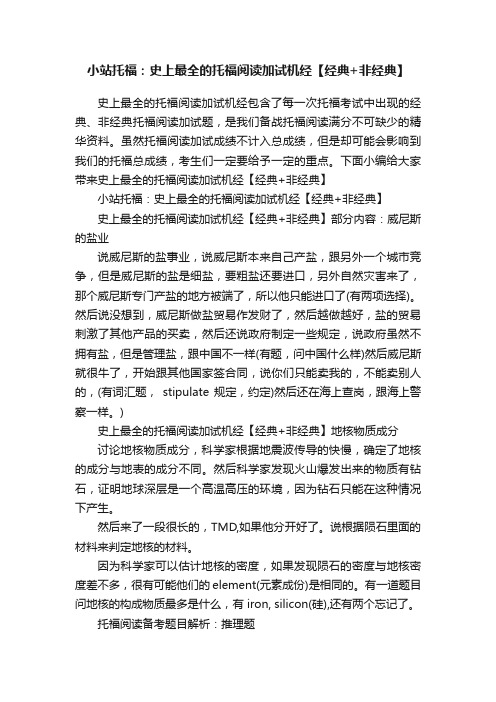
小站托福:史上最全的托福阅读加试机经【经典+非经典】史上最全的托福阅读加试机经包含了每一次托福考试中出现的经典、非经典托福阅读加试题,是我们备战托福阅读满分不可缺少的精华资料。
虽然托福阅读加试成绩不计入总成绩,但是却可能会影响到我们的托福总成绩,考生们一定要给予一定的重点。
下面小编给大家带来史上最全的托福阅读加试机经【经典+非经典】小站托福:史上最全的托福阅读加试机经【经典+非经典】史上最全的托福阅读加试机经【经典+非经典】部分内容:威尼斯的盐业说威尼斯的盐事业,说威尼斯本来自己产盐,跟另外一个城市竞争,但是威尼斯的盐是细盐,要粗盐还要进口,另外自然灾害来了,那个威尼斯专门产盐的地方被端了,所以他只能进口了(有两项选择)。
然后说没想到,威尼斯做盐贸易作发财了,然后越做越好,盐的贸易刺激了其他产品的买卖,然后还说政府制定一些规定,说政府虽然不拥有盐,但是管理盐,跟中国不一样(有题,问中国什么样)然后威尼斯就很牛了,开始跟其他国家签合同,说你们只能卖我的,不能卖别人的,(有词汇题,stipulate 规定,约定)然后还在海上查岗,跟海上警察一样。
)史上最全的托福阅读加试机经【经典+非经典】地核物质成分讨论地核物质成分,科学家根据地震波传导的快慢,确定了地核的成分与地表的成分不同。
然后科学家发现火山爆发出来的物质有钻石,证明地球深层是一个高温高压的环境,因为钻石只能在这种情况下产生。
然后来了一段很长的,TMD,如果他分开好了。
说根据陨石里面的材料来判定地核的材料。
因为科学家可以估计地核的密度,如果发现陨石的密度与地核密度差不多,很有可能他们的element(元素成份)是相同的。
有一道题目问地核的构成物质最多是什么,有 iron, silicon(硅),还有两个忘记了。
托福阅读备考题目解析:推理题一、推理题的两大分类:有共性的推理题和无共性的推理题。
这里所谓的有共性推理题就是说题干中有和原文内容相同的关键词(也叫线索)。
2016年托福阅读模拟试题及答案解析(2)

2016 年托福阅读模拟试题及答案解析 (2)托福阅读试题1.What can be inferred from paragraph 1 aboutBritain's short supply of wood in the eighteenthcentury?A.Wood from Britain’s great forests was beingexported to other countries for profit.B.A growing population had required cutting down forests to increase available land forfarming.rger families required the construction of larger homes made from wood.D.What was left of the great forests after the medieval period was being strictly protected.2.Select TWO answer choices that, according to paragraph 1, are true statementsabout Russia’s iron industry in the eighteenth century. To obtain credit, you mustselect TWO answer choices.A.Russia reached its maximum production of iron at the same time as Britain.B.Russia exported much of its iron production to Britain.C.Russia’s appetite for iron increased rapidly after 1740.D.Russia’s energy resourceseventually became insufficient and limited the growth of its iron industry.3.The word "abundant" in the passage is closest in meaning toA.reliableB.plentifulC.well-preservedD.existing4.Why are "beer, glass, soap, and other products" mentioned in the discussion ofBritain’s energy?A.To help explain why the energy crisis was so severeB.To show that despite the energy crisis and as early as 1640, London homes were advancedand well suppliedC.To emphasize that after 1640, British homes required energy for more than heatD.To indicate that coal had been used for the production of certain products before theeighteenth century5.According to paragraph 3, all of the following are ways in which the Savery andNewcomen engines were similar EXCEPT:A.Both became relatively inexpensive after the 1770s.B.Both produced steam by burning coal.C.Both were used to operate pumps.D.Both were very inefficient.6.The word "gifted" in the passage is closest in meaning toA.independentB.talentedC.famousD.ambitious7.According to paragraph 4, what was James Watt’s major achievement?A. He was able to apply his understanding of physics to invent a variety of scientificinstruments and tools for skilled crafts workers.B.He taught university physics courses to outstanding students whose observations led tomany patented inventions.C.He improved the efficiency of Newcomen’s engine by preventing energy from being lost.D.He redesigned Newcomen’s engine so that it no longer needed a separate condenser.8.The word "splendid" in the passage is closest in meaning toA.originalB.necessaryC.magnificentD.popular9.Which of the following is NOT mentioned in paragraph 5 as a development thatgreatly changed the production of iron?A.The use of coke in the smelting of pig ironB.The invention of a furnace that used coke to refine ironC.The discovery of a method for increasing the production of charcoalD.The invention of powerful machinery that could shape, form, and finish iron10.In paragraph 6, why does the author compare British iron production in 1740 withthat of 1844?A.To contrast the amounts of iron needed in Britain in two different centuriesB.To illustrate how easy it was to make money using Cort’s inventionC.To demonstrate the tremendous growth of the iron industry in BritainD.To demonstrate how inexpensive coal had become11.The word "indispensable" in the passage is closest in meaning toA.advantageousB.essentialC.less costlyD.highly stimulating12.According to the passage, which of the following is true about the development ofsteam power?A.The steam engine’s basic technology can be traced back to medieval Britain when steam-powered machinery was being tried in farming activities.B.Although Russia and Britain developed steam-power technology simultaneously,Britain wasfirst to try it in a large-scale industry due to a greater need for iron.C.Steam-power technology was largely the result of improvements developed to increase thesupply of coal as a primary source of energy.D.Adaptations to steam engines required for their use in cotton-spinning mills led to radicaldevelopments in machinery used in the iron industry.13. Look at the four squares [■] that indicate where the following sentence could beadded to the passage.Where would the sentence best fit? Energy had not been aproblem for Britain in the past because it relied on a rich source of energy: its vastforests.By the eighteenth century,Britain was experiencing a severe shortage of energy. ■【A】 Because of the growth of population, most of the great forests of medieval Britain had longago been replaced by fields of grain and hay. ■【B】Wood was in ever-shorter supply, yet itremained tremendously important.■【C】It served as the primary source of heat for allhomes and industries and as a basic raw material.■【D】Processed wood (charcoal) was thefuel that was mixed with iron ore in the blast furnace to produce pig iron (raw iron). The ironindustry’s appetite for wood was enormous, and by 1740 the British iron industry wasstagnating.Vast forests enabled Russia to become the world’s leading producer of iron,much ofwhich was exported to Britain.But Russia’s potential for growth was limited too,and in a fewdecades Russia would reach the barrier of inadequate energy that was already holdingEngland back.14. Directions: An introductory sentence for a brief summary of the passage of thepassage is provided plete the summary by selecting the THREE answerchoices that express the most important ideas in the passage.Some answer choicesdo not belong in the summary because they express ideas that are not presented inthe passage or are minor ideas in the passage. This questions is worth 2 points.By the eighteenth century,Britain was experiencing a severe shortage of energy.A.The development of blast furnaces for the manufacture of pig iron made the Britain lessdependent on wood.B.After the medieval period, both Russia and Britain began to look for alternative sources ofenergy, such as steam power, in order to maintain the growth of their iron industries.C.Two inventors designed the first steam engines in order to overcome the disadvantages ofrelying on horses to power the pumps used in mining coal.D.James Watt was able to improve upon the efficiency of the steam engine and make it usefulto several industries.E.The puddling furnace increased the availability of charcoal to a variety of industries fromcotton to iron production.F.Steam power increased coal production,which in turn allowed extraordinary growth of theiron industry and the British economy.托福阅读答案1.B2.BD3.B4.D5.A6.B7.C8.C9.C10.C11.B12.C13.A14.CDF。
托福考试阅读试题及答案
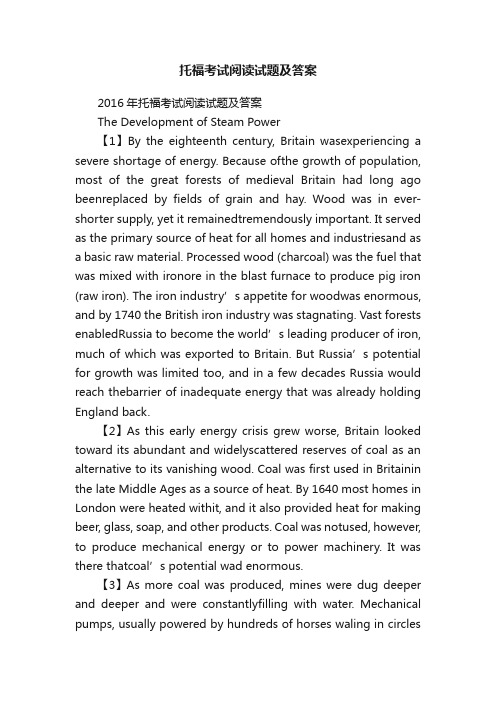
托福考试阅读试题及答案2016年托福考试阅读试题及答案The Development of Steam Power【1】By the eighteenth century, Britain wasexperiencing a severe shortage of energy. Because ofthe growth of population, most of the great forests of medieval Britain had long ago beenreplaced by fields of grain and hay. Wood was in ever-shorter supply, yet it remainedtremendously important. It served as the primary source of heat for all homes and industriesand as a basic raw material. Processed wood (charcoal) was the fuel that was mixed with ironore in the blast furnace to produce pig iron (raw iron). The iron industry’s appetite for woodwas enormous, and by 1740 the British iron industry was stagnating. Vast forests enabledRus sia to become the world’s leading producer of iron, much of which was exported to Britain. But Russia’s potential for growth was limited too, and in a few decades Russia would reach thebarrier of inadequate energy that was already holding England back.【2】As this early energy crisis grew worse, Britain looked toward its abundant and widelyscattered reserves of coal as an alternative to its vanishing wood. Coal was first used in Britainin the late Middle Ages as a source of heat. By 1640 most homes in London were heated withit, and it also provided heat for making beer, glass, soap, and other products. Coal was notused, however, to produce mechanical energy or to power machinery. It was there thatcoal’s potential wad enormous.【3】As more coal was produced, mines were dug deeper and deeper and were constantlyfilling with water. Mechanical pumps, usually powered by hundreds of horses waling in circlesatthe surface, had to be installed Such power was expensive and bothersome. In an attempt toovercome these disadvantages, Thomas Savery in 1698 and Thomas Newcomen in 1705 invented the first primitive steam engines. Both engines were extremely inefficient. Bothburned coal to produce steam, which was then used to operate a pump. However, by theearly 1770s, many of the Savery engines and hundreds of the Newcomen engines wereoperating successfully, though inefficiently, in English and Scottish mines.【4】In the early 1760s, a gifted young Scot named James Watt was drawn to a critical studyof the steam engine. Watt was employed at the time by the University of Glasgow as a skilledcrafts worker making scientific instruments. In 1763: Watt was called on to repair a Newcomenengine being used in a physics course. After a series of observations, Watt saw that theNewcomen’s wast e of energy could be reduced by adding a separate condenser. This splendidinvention, patented in 1769, greatly increased the efficiency of the steam engine. The steamengine of Watt and his followers was the technological advance that gave people, at least for awhile, unlimited power and allowed the invention and use of all kinds of power equipment.【5】The steam engine was quickly put to use in several industries in Britain. It drained minesand made possible the production of ever more coal to feed steam engines elsewhere. Thesteam power plant began to replace waterpower in the cotton-spinning mills as well as otherindustries during the 1780s, contributing to a phenomenal rise in industrialization. TheBritish iron industry was radically transformed. The use of powerful, steam-driven bellows inblast furnaces helped iron makers switchover rapidly from limited charcoal to unlimited coke(which is made from coal) in the smelting of pig iron (the process of refining impure iron) after1770 in the 1780s, Henry Cort developed the puddling furnace, which allowed pig iron to berefined in turn with coke. Cort also developed heavy-duty, steam-powered rolling mills, whichwere capable of producing finished iron in every shape and form.【6】The economic consequence of these technical innovations in steam power was a greatboom in the British iron industry. In 1740 annual British iron production was only 17:000 tons, but by 1844: with the spread of coke smelting and the impact of Cort’s inventions, it hadincreased to 3,000:000 to ns. This was a truly amazing expansion. Once scarce and expensive, iron became cheap, basic, and indispensable to the economy.试题1.What can be inferred from paragraph 1 aboutBritain's short supply of wood in the eighteenthcentury?A.Wood from Britain’s gr eat forests was beingexported to other countries for profit.B.A growing population had required cutting down forests to increase available land forfarming.rger families required the construction of larger homes made from wood.D.What was left of the great forests after the medieval period was being strictly protected.2.Select TWO answer choices that, according to paragraph 1, are true statementsabout Russia’s iron industry in the eighteenth century. To obtain credit, you mustselect TWO answer choices.A.Russia reached its maximum production of iron at the sametime as Britain.B.Russia exported much of its iron production to Britain.C.Russia’s appetite for iron increased rapidly after 1740.D.Russia’s energy resourceseventually became insufficient and limited the growth of its iron industry.3.The word "abundant" in the passage is closest in meaning toA.reliableB.plentifulC.well-preservedD.existing4.Why are "beer, glass, soap, and other products" mentioned in the discussion ofBritain’s energy?A.To help explain why the energy crisis was so severeB.To show that despite the energy crisis and as early as 1640, London homes were advancedand well suppliedC.To emphasize that after 1640, British homes required energy for more than heatD.To indicate that coal had been used for the production of certain products before theeighteenth century5.According to paragraph 3, all of the following are ways in which the Savery andNewcomen engines were similar EXCEPT:A.Both became relatively inexpensive after the 1770s.B.Both produced steam by burning coal.C.Both were used to operate pumps.D.Both were very inefficient.6.The word "gifted" in the passage is closest in meaning toA.independentB.talentedC.famousD.ambitious7.According to paragraph 4, what was Jam es Watt’s major achievement?A. He was able to apply his understanding of physics to invent a variety of scientificinstruments and tools for skilled crafts workers.B.He taught university physics courses to outstanding students whose observations led tomany patented inventions.C.He improved the efficiency of Newcomen’s engine by preventing energy from being lost.D.He redesigned Newcomen’s engine so that it no longer needed a separate condenser.8.The word "splendid" in the passage is closest in meaning toA.originalB.necessaryC.magnificentD.popular9.Which of the following is NOT mentioned in paragraph 5 as a development thatgreatly changed the production of iron?A.The use of coke in the smelting of pig ironB.The invention of a furnace that used coke to refine ironC.The discovery of a method for increasing the production of charcoalD.The invention of powerful machinery that could shape, form, and finish iron10.In paragraph 6, why does the author compare British iron production in 1740 withthat of 1844?A.To contrast the amounts of iron needed in Britain in two different centuriesB.To illustrate how easy it was to make money using Cort’s inventionC.To demonstrate the tremendous growth of the iron industry in BritainD.To demonstrate how inexpensive coal had become11.The word "indispensable" in the passage is closest in meaning toA.advantageousB.essentialC.less costlyD.highly stimulating12.According to the passage, which of the following is true about the development ofsteam power?A.The steam e ngine’s basic technology can be traced back to medieval Britain when steam-powered machinery was being tried in farming activities.B.Although Russia and Britain developed steam-power technology simultaneously, Britain wasfirst to try it in a large-scale industry due to a greater need for iron.C.Steam-power technology was largely the result of improvements developed to increase thesupply of coal as a primary source of energy.D.Adaptations to steam engines required for their use in cotton-spinning mills led to radicaldevelopments in machinery used in the iron industry.13. Look at the four squares [■] that indicate where the following sentence could beadded to the passage. Where would the sentence best fit? Energy had not been aproblem for Britain in the past because it relied on a rich source of energy: its vastforests.By the eighteenth century, Britain was experiencing a severe shortage of energy. ■【A】 Because of the growth of population, most of the great forests of medieval Britain had longago been repl aced by fields of grain and hay. ■【B】Wood was in ever-shorter supply, yet itremained tremendously important. ■【C】It served as the primary source of heat for allhomes and industries and as a basic raw material. ■【D】Processed wood (charcoal) was thefuel that was mixed with iron ore in the blast furnace to produce pig iron (raw iron). The ironindustry’s appetite for wood was enormous, and by 1740 the British iron industry wasstagnating. Vast forests enabled Russia to become the world’s leading producer of iron, much ofwhich was exported to Britain. But Russia’s potential for growth was limited too, and in a fewdecades Russia would reach the barrier of inadequate energy that was already holdingEngland back.14. Directions: An introductory sentence for a brief summary of the passage of thepassage is provided below. Complete the summary by selecting the THREE answerchoices that express the most important ideas in the passage. Some answer choicesdo not belong in the summary because they express ideas that are not presented inthe passage or are minor ideas in the passage. This questions is worth 2 points.By the eighteenth century, Britain was experiencing a severe shortage of energy.A.The development of blast furnaces for the manufacture of pig iron made the Britain lessdependent on wood.B.After the medieval period, both Russia and Britain began to look for alternative sources ofenergy, such as steam power, in order to maintain the growth of their iron industries.C.Two inventors designed the first steam engines in order toovercome the disadvantages ofrelying on horses to power the pumps used in mining coal.D.James Watt was able to improve upon the efficiency of the steam engine and make it usefulto several industries.E.The puddling furnace increased the availability of charcoal to a variety of industries fromcotton to iron production.F.Steam power increased coal production, which in turn allowed extraordinary growth of theiron industry and the British economy.参考答案1.B2.BD3.B4.D5.A6.B7.C8.C9.C 10.C 11.B 12.C 13.A 14.CDF。
2016年2月28日托福阅读解析
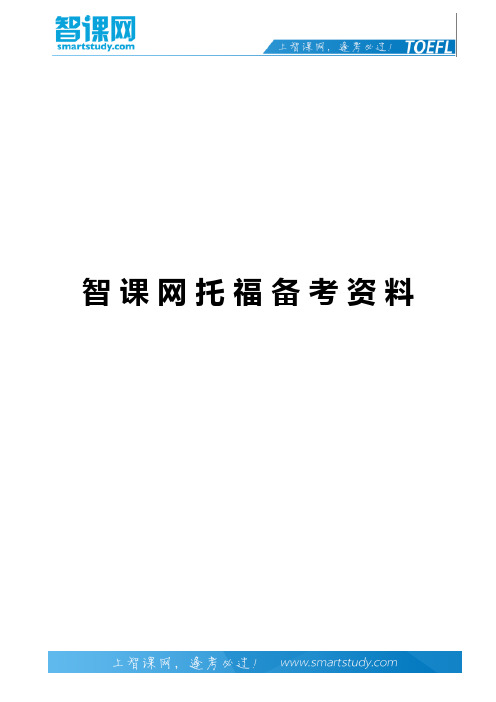
智 课 网 托 福 备 考 资 料2016年2月28日托福阅读解析2月28日托福阅读第一篇题材划分: 贸易类主要内容:欧洲15世纪的羊毛产业。
由城市发展到农村,由城市发展到农村的原因是城市的手工业被类似行业协会的组织控制价格,而农村不受控制,所以价格较低,于是商人进入农村收购产品。
采用承包生产机制,提到了西班牙。
十五世纪变成了羊毛主要出口国,西班牙大量出口羊到意大利和英国,英国变成了主要进口国,英国进行成品加工。
然后英国因为水车的原因布匹处理速度很大提升,要把各种东西打在布匹上使布匹软化的工序原来需要很多人,有了水车后一个人就能搞定了。
然后由于伦敦靠海,布匹产量大,使得贸易很方便,伦敦人口越来越多也更加繁华了。
新型生产模式使得新公司大量涌入市场,老公司觉得破坏了原有生产模式。
部分北欧政府限制老公司的资源,以更好的保护员工等。
相似TPO练习推荐TPO10-Seventeenth-Century European Economic Growth相关背景知识:Between 1450 and 1800, textile production was second only to agriculture in economic importance. It employed more people and produced more profit than any other manufactured product. Production and trade existed at two levels. Everywhere peasants and villagers turned locally grown wool and flax into fabric and clothing for themselves and their neighbors. The cloth they produced was of poor quality and not designed for export to distant markets. On top of this local market sat a large and lucrative luxury trade in silk, wool, linen, and (eventually) cotton fabric, the most important of which were heavy woolens. The customers for these fabrics were wealthy landowners, government and church officials, merchants, financiers, aristocrats, and master craftsmen in Europe, Asia and the Levant.Ireland and the Baltic region supplied much of Europe's flax, although it was widely grown and available. In the sixteenth century, Venice and other Italian cities acquired silkworms and mulberry trees, and began silk manufacturing. From there, the silk industry made its way north to Holland, Zurich, Lyon, Cologne, and Spital fields (East London), England. At the same time, cotton thread and fabric began to arrive from India and became wildly popular.Most important of all the textile industries was the trade in raw wool and wool fabric. Sheep raising abounded everywhere. In the fifteenth century, the best fleeces came from England. In the sixteenth century, Spanish merino sheep knocked English sheep into second place. French sheep were considered to produce the third best wool. Two types of wool fabric were produced in Europe—woolens and worsteds. Of the two, the market for woolens was by far the larger. Woolens were made from short-staple wool fibers that were swirled together before spinning. The cloth had a soft-textured appearance and feel. Worsteds were made from long-staple wool and had a harder, smoother finish. Soft woolens were considered far more desirable than the harsher worsteds and dominated the wool trade.In the fifteenth century, textile manufacturing was an urban industry, controlled by wealthy merchants (drapers) who purchased raw wool, had it turned into cloth, and then sold it, often to other craftsmen who performed the final finishing steps, including dyeing and teaseling. These were capital-intensive crafts, and cloth merchants often preferred not to be involved in them. Before the seventeenth century, most English cloth was dyed and finished in Holland. In England, in addition to merchants who only bought and sold, clothiers, themselves often master weavers, controlled a great deal of the woolen trade.In the fifteenth and sixteenth centuries, textile workers dominated the population of towns like Venice and Leiden. By the sixteenth century, however, merchants had discovered that they could avoid the high wages, labor shortages, and quality controls imposed by urban guilds and governments by hiring peasants to do manufacturing work in their homes. Urban merchants continued to control production, but much of the work force was spread out through the countryside. Alternately referred to as the putting-out system, cottage manufacturing, and the Verlag system, merchants (Verlagers) found they could save money (rural workers could work for less because they produced much of their own food) and increase production at the same time. Trained cottage workers could be as skilled as urban workers, but many alternated farming and manufacturing and produced goods of lesser quality. The high-end woolen trade remained important, but many merchants began to reorient their businesses away from the luxury market and toward lower-quality, lower-priced, and more rapidly produced goods.。
2016年3月26日托福真题机经
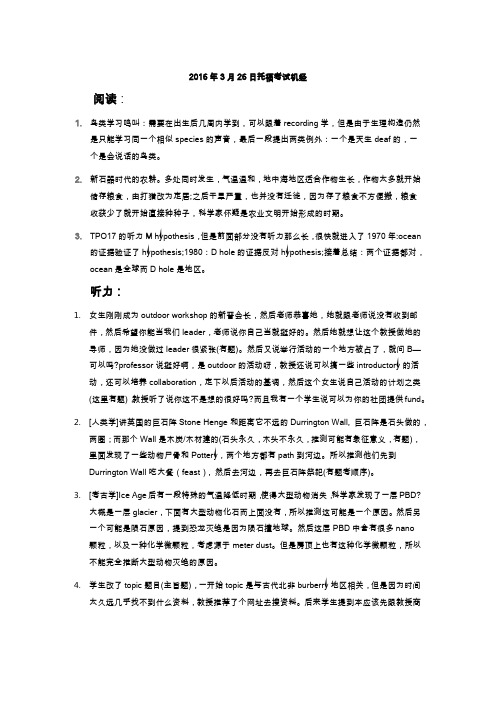
2016年3月26日托福考试机经阅读:1.鸟类学习鸣叫:需要在出生后几周内学到,可以跟着recording学,但是由于生理构造仍然是只能学习同一个相似species的声音,最后一段提出两类例外:一个是天生deaf的,一个是会说话的鸟类。
2.新石器时代的农耕。
多处同时发生,气温温和,地中海地区适合作物生长,作物太多就开始储存粮食,由打猎改为定居;之后干旱严重,也并没有迁徙,因为存了粮食不方便搬,粮食收获少了就开始直接种种子,科学家怀疑是农业文明开始形成的时期。
3.TPO17的听力M hypothesis,但是前面部分没有听力那么长,很快就进入了1970年:ocean的证据验证了hypothesis;1980:D hole的证据反对hypothesis;接着总结:两个证据都对,ocean是全球而D hole是地区。
听力:1.女生刚刚成为outdoor workshop的新晋会长,然后老师恭喜她,她就跟老师说没有收到邮件,然后希望你能当我们leader,老师说你自己当就挺好的。
然后她就想让这个教授做她的导师,因为她没做过leader很紧张(有题)。
然后又说举行活动的一个地方被占了,就问B—可以吗?professor说挺好啊,是outdoor的活动呀,教授还说可以搞一些introductory的活动,还可以培养collaboration,定下以后活动的基调,然后这个女生说自己活动的计划之类(这里有题),教授听了说你这不是想的很好吗?而且我有一个学生说可以为你的社团提供fund。
2.[人类学]讲英国的巨石阵Stone Henge和距离它不远的Durrington Wall, 巨石阵是石头做的,两圈;而那个Wall是木炭/木材建的(石头永久,木头不永久,推测可能有象征意义,有题),里面发现了一些动物尸骨和Pottery,两个地方都有path到河边。
所以推测他们先到Durrington Wall吃大餐(feast), 然后去河边,再去巨石阵祭祀(有题考顺序)。
2016.05.22托福阅读真题回顾与解析
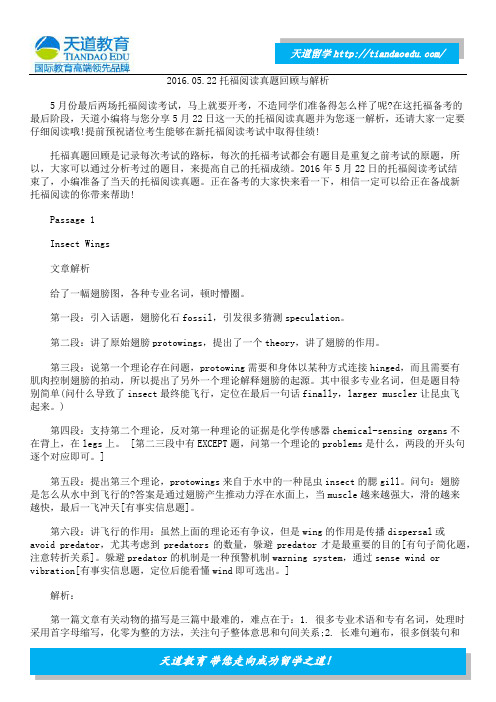
2016.05.22托福阅读真题回顾与解析5月份最后两场托福阅读考试,马上就要开考,不造同学们准备得怎么样了呢?在这托福备考的最后阶段,天道小编将与您分享5月22日这一天的托福阅读真题并为您逐一解析,还请大家一定要仔细阅读哦!提前预祝诸位考生能够在新托福阅读考试中取得佳绩!托福真题回顾是记录每次考试的路标,每次的托福考试都会有题目是重复之前考试的原题,所以,大家可以通过分析考过的题目,来提高自己的托福成绩。
2016年5月22日的托福阅读考试结束了,小编准备了当天的托福阅读真题。
正在备考的大家快来看一下,相信一定可以给正在备战新托福阅读的你带来帮助!Passage 1Insect Wings文章解析给了一幅翅膀图,各种专业名词,顿时懵圈。
第一段:引入话题,翅膀化石fossil,引发很多猜测speculation。
第二段:讲了原始翅膀protowings,提出了一个theory,讲了翅膀的作用。
第三段:说第一个理论存在问题,protowing需要和身体以某种方式连接hinged,而且需要有肌肉控制翅膀的拍动,所以提出了另外一个理论解释翅膀的起源。
其中很多专业名词,但是题目特别简单(问什么导致了insect最终能飞行,定位在最后一句话finally,larger muscler让昆虫飞起来。
)第四段:支持第二个理论,反对第一种理论的证据是化学传感器chemical-sensing organs不在背上,在legs上。
[第二三段中有EXCEPT题,问第一个理论的problems是什么,两段的开头句逐个对应即可。
]第五段:提出第三个理论,protowings来自于水中的一种昆虫insect的腮gill。
问句:翅膀是怎么从水中到飞行的?答案是通过翅膀产生推动力浮在水面上,当muscle越来越强大,滑的越来越快,最后一飞冲天[有事实信息题]。
第六段:讲飞行的作用:虽然上面的理论还有争议,但是wing的作用是传播dispersal或avoid predator,尤其考虑到predators的数量,躲避predator才是最重要的目的[有句子简化题,注意转折关系]。
2016年托福阅读模拟试题及答案解析(6)
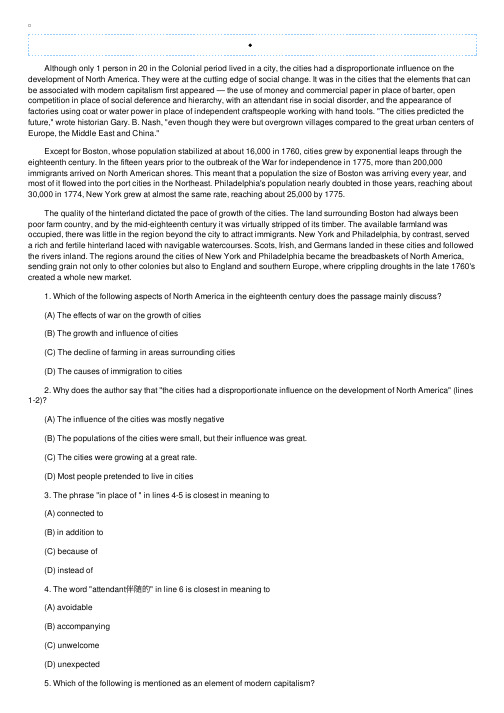
Although only 1 person in 20 in the Colonial period lived in a city, the cities had a disproportionate influence on the development of North America. They were at the cutting edge of social change. It was in the cities that the elements that can be associated with modern capitalism first appeared — the use of money and commercial paper in place of barter, open competition in place of social deference and hierarchy, with an attendant rise in social disorder, and the appearance of factories using coat or water power in place of independent craftspeople working with hand tools. "The cities predicted the future," wrote historian Gary. B. Nash, "even though they were but overgrown villages compared to the great urban centers of Europe, the Middle East and China." Except for Boston, whose population stabilized at about 16,000 in 1760, cities grew by exponential leaps through the eighteenth century. In the fifteen years prior to the outbreak of the War for independence in 1775, more than 200,000 immigrants arrived on North American shores. This meant that a population the size of Boston was arriving every year, and most of it flowed into the port cities in the Northeast. Philadelphia's population nearly doubted in those years, reaching about 30,000 in 1774, New York grew at almost the same rate, reaching about 25,000 by 1775. The quality of the hinterland dictated the pace of growth of the cities. The land surrounding Boston had always been poor farm country, and by the mid-eighteenth century it was virtually stripped of its timber. The available farmland was occupied, there was little in the region beyond the city to attract immigrants. New York and Philadelphia, by contrast, served a rich and fertile hinterland laced with navigable watercourses. Scots, Irish, and Germans landed in these cities and followed the rivers inland. The regions around the cities of New York and Philadelphia became the breadbaskets of North America, sending grain not only to other colonies but also to England and southern Europe, where crippling droughts in the late 1760's created a whole new market. 1. Which of the following aspects of North America in the eighteenth century does the passage mainly discuss? (A) The effects of war on the growth of cities (B) The growth and influence of cities (C) The decline of farming in areas surrounding cities (D) The causes of immigration to cities 2. Why does the author say that "the cities had a disproportionate influence on the development of North America" (lines 1-2)? (A) The influence of the cities was mostly negative (B) The populations of the cities were small, but their influence was great. (C) The cities were growing at a great rate. (D) Most people pretended to live in cities 3. The phrase "in place of " in lines 4-5 is closest in meaning to (A) connected to (B) in addition to (C) because of (D) instead of 4. The word "attendant伴随的" in line 6 is closest in meaning to (A) avoidable (B) accompanying (C) unwelcome (D) unexpected 5. Which of the following is mentioned as an element of modern capitalism? (B) Social deference (C) Social hierarchy (D) Independent craftspeople 6. It can be inferred that in comparison with North American cities, cities in Europe, the Middle East, and China had (A) large populations (B) little independence (C) frequent social disorder (D) few power sources 7. The phrase "exponential迅猛的 leaps" in line 12 is closest in meaning to (A) long wars (B) new laws (C) rapid increases (D) exciting changes 8. The word "it" in line 15 refers to (A) population (B) size (C) Boston (D) Year 9. How many immigrants arrived in North America between 1760 and 1775? (A) About 16,000 (B) About 25,000 (C) About 30,000 (D) More than 200,000 10. The word "dictated决定" in line 18 is closest in meaning to (A) spoiled (B) reduced (C) determined (D) divided 11. The word "virtually⼏乎" in line 20 is closest in meaning to (A) usually (B) hardly (C) very quickly (D) almost completely 12. The region surrounding New York and Philadelphia is contrasted with the region surrounding Boston in terms of (B) origin of immigrants (C) opportunities for fishing (D) type of grain grown 13. Why does the author describe the regions around the cities of New York and Philadelphia as "breadbaskets"? (A) They produced grain especially for making bread. (B) They stored large quantities of grain during periods of drought (C) They supplied grain to other parts of North America and other countries. (D) They consumed more grain than all the other regions of North America. BBDBA ACADC DAC。
2016年托福阅读模拟试题及答案解析(1)
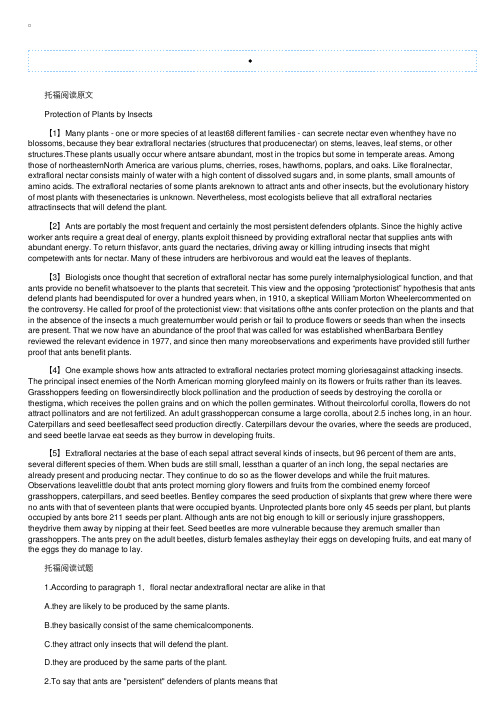
托福阅读原⽂ Protection of Plants by Insects 【1】Many plants - one or more species of at least68 different families - can secrete nectar even whenthey have no blossoms, because they bear extrafloral nectaries (structures that producenectar) on stems, leaves, leaf stems, or other structures.These plants usually occur where antsare abundant, most in the tropics but some in temperate areas. Among those of northeasternNorth America are various plums, cherries, roses, hawthorns, poplars, and oaks. Like floralnectar, extrafloral nectar consists mainly of water with a high content of dissolved sugars and, in some plants, small amounts of amino acids. The extrafloral nectaries of some plants areknown to attract ants and other insects, but the evolutionary history of most plants with thesenectaries is unknown. Nevertheless, most ecologists believe that all extrafloral nectaries attractinsects that will defend the plant. 【2】Ants are portably the most frequent and certainly the most persistent defenders ofplants. Since the highly active worker ants require a great deal of energy, plants exploit thisneed by providing extrafloral nectar that supplies ants with abundant energy. To return thisfavor, ants guard the nectaries, driving away or killing intruding insects that might competewith ants for nectar. Many of these intruders are herbivorous and would eat the leaves of theplants. 【3】Biologists once thought that secretion of extrafloral nectar has some purely internalphysiological function, and that ants provide no benefit whatsoever to the plants that secreteit. This view and the opposing “protectionist” hypothesis that ants defend plants had beendisputed for over a hundred years when, in 1910, a skeptical William Morton Wheelercommented on the controversy. He called for proof of the protectionist view: that visitations ofthe ants confer protection on the plants and that in the absence of the insects a much greaternumber would perish or fail to produce flowers or seeds than when the insects are present. That we now have an abundance of the proof that was called for was established whenBarbara Bentley reviewed the relevant evidence in 1977, and since then many moreobservations and experiments have provided still further proof that ants benefit plants. 【4】One example shows how ants attracted to extrafloral nectaries protect morning gloriesagainst attacking insects. The principal insect enemies of the North American morning gloryfeed mainly on its flowers or fruits rather than its leaves. Grasshoppers feeding on flowersindirectly block pollination and the production of seeds by destroying the corolla or thestigma, which receives the pollen grains and on which the pollen germinates. Without theircolorful corolla, flowers do not attract pollinators and are not fertilized. An adult grasshoppercan consume a large corolla, about 2.5 inches long, in an hour. Caterpillars and seed beetlesaffect seed production directly. Caterpillars devour the ovaries, where the seeds are produced, and seed beetle larvae eat seeds as they burrow in developing fruits. 【5】Extrafloral nectaries at the base of each sepal attract several kinds of insects, but 96 percent of them are ants, several different species of them. When buds are still small, lessthan a quarter of an inch long, the sepal nectaries are already present and producing nectar. They continue to do so as the flower develops and while the fruit matures. Observations leavelittle doubt that ants protect morning glory flowers and fruits from the combined enemy forceof grasshoppers, caterpillars, and seed beetles. Bentley compares the seed production of sixplants that grew where there were no ants with that of seventeen plants that were occupied byants. Unprotected plants bore only 45 seeds per plant, but plants occupied by ants bore 211 seeds per plant. Although ants are not big enough to kill or seriously injure grasshoppers, theydrive them away by nipping at their feet. Seed beetles are more vulnerable because they aremuch smaller than grasshoppers. The ants prey on the adult beetles, disturb females astheylay their eggs on developing fruits, and eat many of the eggs they do manage to lay. 托福阅读试题 1.According to paragraph 1,floral nectar andextrafloral nectar are alike in that A.they are likely to be produced by the same plants. B.they basically consist of the same chemicalcomponents. C.they attract only insects that will defend the plant. D.they are produced by the same parts of the plant. 2.To say that ants are "persistent" defenders of plants means that A.they defend plants against a wide variety of threats. B.they continue to defend plants for as long as the plants are threatened. C.they are successful defenders of plants. D.they are easily observable defenders of plants. 3.What can be inferred from paragraph 2 about the ants that are attracted to theextrafloral nectaries? A.They do not eat the leaves of the plants that produce extrafloral nectar. B.They live almost entirely on extrafloral nectar. C.They spend most of their energy guarding extrafloral nectaries. D.They frequently fight among themselves over extrafloral nectar. 4.According to paragraph 3, what was the position of the opponents of the"protectionist" hypothesis? A.Extrafloral nectar provides plants with a direct defense against attack by insects. B.Ants substantially benefit plants that secrete extrafloral nectar. C.The secretion of extrafloral nectar plays a role in the plant’s internal functioning. D.Ants visit plants that secrete extrafloral nectar as often as they visit plants that do not. 5.The word "skeptical" in the passage is closest in meaning to A.curious. B.doubtful. C.open-minded. D.practical. 6.Which of the sentences below best expresses the essential information jn thehighlighted sentence in the passage Incorrect choices change the meaning inimportant ways or leave out essential information. A.We now have ample proof that ants benefit plants. B.Barbara Bentley has called for additional proof that ants benefit plants. C.In 1977 Barbara Bentley conducted research that proved that all prior studies were wrong. D.Proof that ants benefit plants will require many more observations and experiments. 7.According to paragraph 4, what effect does the destruction of the corolla have onplants. A.It leaves the seeds exposed and unprotected. B.It prevents the stigma from developing. C.It keeps pollen grains from attaching properly. D.It prevents the flower from attracting pollinators. 8.The word "devour" in the passage is closest in meaning to A.attack. B.eat. C.damage. D.prefer. 9.What role does paragraph 5 play in the passage? A.It offers various kinds of evidence for the protectionist view. B.It presents the study that first proved that ants benefit plants. C.It explains how insects find sources of nectar. D.It presents information that partly contradicts the protectionist view. 10.The word "vulnerable" in the passage is closest in meaning to A.numerous. B.harmful. C.open to attack. D.difficult to locate. 11.According to paragraph 5, what did Bentley’s comparative study show? A.Many more plants grew in places where ants were present than where they were absent. B.The ants preferred plants with low seed production to plants with high seed production. C.The plants occupied by ants produced many more seeds than those that were not occupiedby ants. D.The plants that grew in places without ants were much smaller and weaker than those thatgrew in places where ants were present. 12.According to paragraph 5, ants defend morning glory plants from seed beetles ineach of the following ways EXCEPT: A.driving adult beetles off the plants by nipping at their feet. B.catching and eating adult beetles. C.eating beetle eggs they find on developing fruits. D.making it difficult for beetles to lay eggs on developing fruits. 13. Look at the four squares [■] that indicate where the following sentence could beadded to the passage. Where would the sentence best fit? Sometimes they capture theinsects to feed their protein-hungry larvae. Ants are portably the most frequent and certainly the most persistent defenders of plants. ■【A】 Since the highly active worker ants require a great deal of energy, plants exploit thisneed by providing extrafloral nectar that supplies ants with abundant energy. ■【B】 Toreturn this favor, ants guard the nectaries, driving away or killing intruding insects that mightcompete with ants for nectar. ■【C】 Many of these intruders are herbivorous and would eatthe leaves of the plants.■【D】 14. Directions: An introductory sentence for a brief summary of the passage of thepassage is provided below. Complete the summary by selecting the THREE answerchoices that express the most important ideas in the passage. Some answer choicesdo not belong in the summary because they express ideas that are not presented inthe passage or are minor ideas in the passage. This questions is worth 2 points. Many plants have extrafloral nectaries that produce nectar even during periods inwhich the plant is not flowering. A.Evolutionary history shows that plants that produce extrafloral nectar originated in thetropics. B.Extrafloral nectar has a higher concentration of sugar than f l o r a l n e c t a r a n d i s m o r e a t t r a c t i v e t o a n t s a n d o t h e r i n s e c t s . / p > p b d s f i d = " 1 5 0 " > 0 0 C . T h e p r o t e c t i o n i s t h y p o t h e s i s i s t h a t e x t r a f l o r a l n e x t a r a t t r a c t s a n t s , a n d t h a t t h e a n t s , i n o r d e r t o p r e s e r v e t h i s e n e r g y - r i c h f o o d s o u r c e , a t t a c k i n s e c t s t h a t m i g h t h a r m t h e p l a n t . / p > p b d s f i d = " 1 5 1 " > 0 0 D . E v i d e n c e a c c u m u l a t e d d u r i n g t h e t w e n t i e t h c e n t u r y p r o v e d t h a t a n t s p r o v i d e s i g n i f i c a n t b e n e f i t s f o r p l a n t s w i t h e x t r a f l o r a l n e c t a r i e s . / p > p b d s f i d = " 1 5 2 " > 0 0 E . R e s e a r c h h a s s h o w n t h a t A m e r i c a n m o r n i n g g l o r y p l a n t s t h a t a r e p r o t e c t e d b y a n t s p r o d u c e s i g n i f i c a n t l y m o r e s e e d s t h a n m o r n i n g g l o r y p l a n t s t h a t a r e n o t p r o t e c t e d b y a n t s . / p > p b d s f i d = " 1 5 3 " > 0 0 F . A n t s g e n e r a l l y i g n o r e s m a l l i n s e c t s , b u t t h e y w i l l e a t t h e a d u l t s o f l a r g e i n s e c t s p e c i e s a s w e l l a s t h e i r e g g s a n d l a r v a e . / p > p b d s f i d = " 1 5 4 " > / p >。
托福阅读11月2日考试机经
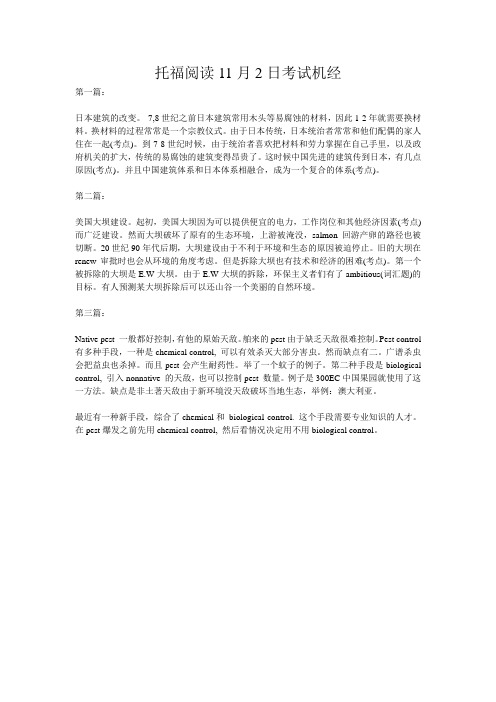
托福阅读11月2日考试机经第一篇:日本建筑的改变。
7,8世纪之前日本建筑常用木头等易腐蚀的材料,因此1-2年就需要换材料。
换材料的过程常常是一个宗教仪式。
由于日本传统,日本统治者常常和他们配偶的家人住在一起(考点)。
到7-8世纪时候,由于统治者喜欢把材料和劳力掌握在自己手里,以及政府机关的扩大,传统的易腐蚀的建筑变得昂贵了。
这时候中国先进的建筑传到日本,有几点原因(考点)。
并且中国建筑体系和日本体系相融合,成为一个复合的体系(考点)。
第二篇:美国大坝建设。
起初,美国大坝因为可以提供便宜的电力,工作岗位和其他经济因素(考点)而广泛建设。
然而大坝破坏了原有的生态环境,上游被淹没,salmon 回游产卵的路径也被切断。
20世纪90年代后期,大坝建设由于不利于环境和生态的原因被迫停止。
旧的大坝在renew审批时也会从环境的角度考虑。
但是拆除大坝也有技术和经济的困难(考点)。
第一个被拆除的大坝是E.W大坝。
由于E.W大坝的拆除,环保主义者们有了ambitious(词汇题)的目标。
有人预测某大坝拆除后可以还山谷一个美丽的自然环境。
第三篇:Native pest 一般都好控制,有他的原始天敌。
舶来的pest由于缺乏天敌很难控制。
Pest control 有多种手段,一种是chemical control, 可以有效杀灭大部分害虫。
然而缺点有二。
广谱杀虫会把益虫也杀掉。
而且pest会产生耐药性。
举了一个蚊子的例子。
第二种手段是biological control, 引入nonnative 的天敌,也可以控制pest 数量。
例子是300EC中国果园就使用了这一方法。
缺点是非土著天敌由于新环境没天敌破坏当地生态,举例:澳大利亚。
最近有一种新手段,综合了chemical和biological control. 这个手段需要专业知识的人才。
在pest爆发之前先用chemical control, 然后看情况决定用不用biological control。
托福考试阅读理解专项训练与答案

托福考试阅读理解专项训练与答案2016年托福考试阅读理解专项训练与答案阅读理解part ALake Baikal1 Crescent-shaped Lake Baikal, in Siberia, is only the ninth largest lake in area at 385 miles (650 km) in length and 46 miles (74 km) in width, yet it is easily the largest body of fresh water in the world. It holds one-fifth of the world's total fresh water, which is more than the total of all the water in the five Great Lakes; it holds so much fresh water in spite of its less-than-impressive area because it is by far the world's deepest lake. The average depth of the lake is 1,312 feet (400 meters) below sea level, and the Olkhon Crevice, the lowest known point, is more than 5,250 feet (1,600 meters) deep.2 Lake Baikal, which today is located near the center of the Asian peninsula, is most likely the world's oldest lake. It began forming 25 million years ago as Asia started splitting apart in a series of great faults. The Baikal Valley dropped away, eventually filling with water and creating the deepest of the world's lakes.1. What is stated in paragraph 1 about the shape of Lake Baikal?(A) It is wider than it is long.(B) It is circular in shape.(C) Its width is one-half of its length.(D) It is shaped like a new moon.2. It is indicated in paragraph 1 that the area of Lake Baikal(A) is less than the area of eight other lakes(B) is one-ninth the area of Siberia(C) is greater than the area of any other freshwater lake(D) is equal to the area of the five Great Lakes3. According to paragraph 1, Lake Baikal(A) holds one-fifth of the world's water(B) holds five times the water of the Great Lakes(C) holds one-ninth of the world's water(D) holds 20 percent of the world's fresh water4. According to paragraph 1, the Olkhon Crevice is(A) outside of Lake Baikal(B) 400 meters below sea level(C) the deepest part of Lake Baikal(D) 5,000 meters deep5. It is mentioned in paragraph 2 that Lake Baikal(A) is not as old as some other lakes(B) formed when sections of the Earth were moving away from each other(C) was fully formed 25 million years ago(D) is today located on the edge of the Asian peninsula参考答案:1-5:D、A、D、C、Bpart BThe Postage Stamp1 The postage stamp has been around for only a relatively short period of time. The use of stamps for postage was first proposed in England in 1837, when Sir Rowland Hill published a pamphlet entitled "Post Office Reform: Its Importance and Practicability" to put forth the ideas that postal rates should not be based on the distance that a letter or package travels but should instead be based on the weight of the letter or package and that fees for postal services should be collected in advanceof the delivery, rather than after, through the use of postage stamps.2 The ideas proposed by Hill went into effect in England almost immediately, and other countries soon followed suit. The first English stamp, which featured a portrait of then Queen Victoria, was printed in 1840. This stamp, the "penny black," came in sheets that needed to be separated with scissors and provided enough postage for a letter weighing 14 grams or less to any destination. In 1843, Brazil was the next nation to produce national postage stamps, and various areas in what is today Switzerland also produced postage stamps later in the same year. Postage stamps in five-and ten-cent denominations were first approved by the U.S. Congress in 1847, and by 1860 postage stamps were being issued in more than 90 governmental jurisdictions worldwide.6. According to paragraph 1, postage stamps were first suggested(A) in the first half of the eighteenth century(B) in the second half of the eighteenth century(C) in the first half of the nineteenth century(D) in the second half of the nineteenth century7. It is indicated in paragraph 1 that Sir Rowland Hill believed that postage fees(A) should be paid by the sender(B) should be related to distance(C) should have nothing to do with how heavy a package is(D) should be collected after the package is delivered8. What is stated in paragraph 2 about the first English postage stamp?(A) It was designed by Queen Victoria.(B) It contained a drawing of a black penny.(C) It was produced in sheets of 14 stamps.(D) It could be used to send a lightweight letter.9. According to paragraph 2, Brazil introduced postage stamps(A) before England(B) before Switzerland(C) after the United States(D) after Switzerland10. It is mentioned in paragraph 2 that in 1847(A) postage stamps were in use in 90 different countries(B) it cost fifteen cents to mail a letter in the United States(C) two different denominations of postage stamps were introduced in the United States(D) the U.S. Congress introduced the "penny black" stamp参考答案:6-10:A、A、D、B、Cpart CThe Clovis Culture1 Archeologists have found sites all over North America that contain similar tools dating from a period about 12,000 years ago. The culture that developed these tools has been named Clovis after the site near Clovis, New Mexico, where the first tools of this sort were discovered in 1932. The tools are quite sophisticated and are unlike any tools that have been found in the Old World.2 In the years since the first tools of this sort were discovered in New Mexico, archeologists have discovered Clovis tools in areas ranging from Mexico to Montana in the United States and Nova Scotia in Canada. All of the Clovis finds date from approximately the same period, a fact which suggests that the Clovis spread rapidly throughout the North American continent.3 From the evidence that has been discovered, archeologists have concluded that the Clovis were a mobile culture. They traveled in groups of 40 to 50 individuals, migrating seasonally and returning to the same hunting camps each year. Their population increased rapidly as they spread out over the continent, and they were quite possibly motivated to develop their sophisticated hunting tools to feed their rapidly expanding populace.11. What is stated in paragraph 1 about Clovis tools?(A) They date from around 10,000 B.C.(B) They have been in use for 12,000 years.(C) They have been found at only one location.(D) They were discovered by archeologists hundreds of years ago.12. According to paragraph 1, the town of Clovis(A) is in Mexico(B) was founded in 1932(C) is where all members of the Clovis culture lived(D) is where the first remnants of an ancient culture were found13. It is indicated in paragraph 1 that the tools found near Clovis, New Mexico, were(A) very rudimentary(B) similar to others found prior to 1932(C) rather advanced(D) similar to some found in Africa and Europe14. According to paragraph 2, what conclusion have archeologists drawn from the Clovis finds?(A) That the Clovis tended to remain in one place(B) That the Clovis expanded relatively quickly(C) That the Clovis lived throughout the world(D) That the Clovis were a seafaring culture15. It is mentioned in paragraph 3 that it is believed that the Clovis(A) lived in familial groups of four or five people(B) had a relatively stable population(C) lived only in New Mexico(D) spent summers and winters in different places参考答案:11-15:A、D、C、B、D。
来来来!0716托福考试阅读真题备好喽
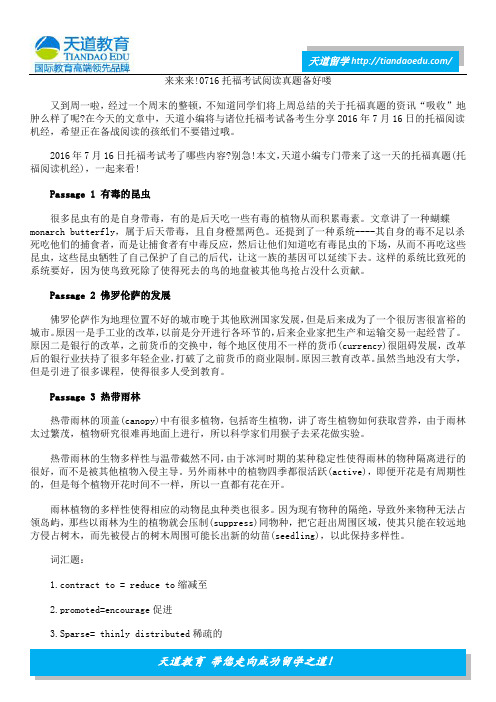
来来来!0716托福考试阅读真题备好喽又到周一啦,经过一个周末的整顿,不知道同学们将上周总结的关于托福真题的资讯“吸收”地肿么样了呢?在今天的文章中,天道小编将与诸位托福考试备考生分享2016年7月16日的托福阅读机经,希望正在备战阅读的孩纸们不要错过哦。
2016年7月16日托福考试考了哪些内容?别急!本文,天道小编专门带来了这一天的托福真题(托福阅读机经),一起来看!Passage 1 有毒的昆虫很多昆虫有的是自身带毒,有的是后天吃一些有毒的植物从而积累毒素。
文章讲了一种蝴蝶monarch butterfly,属于后天带毒,且自身橙黑两色。
还提到了一种系统----其自身的毒不足以杀死吃他们的捕食者,而是让捕食者有中毒反应,然后让他们知道吃有毒昆虫的下场,从而不再吃这些昆虫,这些昆虫牺牲了自己保护了自己的后代,让这一族的基因可以延续下去。
这样的系统比致死的系统要好,因为使鸟致死除了使得死去的鸟的地盘被其他鸟抢占没什么贡献。
Passage 2 佛罗伦萨的发展佛罗伦萨作为地理位置不好的城市晚于其他欧洲国家发展,但是后来成为了一个很厉害很富裕的城市。
原因一是手工业的改革,以前是分开进行各环节的,后来企业家把生产和运输交易一起经营了。
原因二是银行的改革,之前货币的交换中,每个地区使用不一样的货币(currency)很阻碍发展,改革后的银行业扶持了很多年轻企业,打破了之前货币的商业限制。
原因三教育改革。
虽然当地没有大学,但是引进了很多课程,使得很多人受到教育。
Passage 3 热带雨林热带雨林的顶盖(canopy)中有很多植物,包括寄生植物,讲了寄生植物如何获取营养,由于雨林太过繁茂,植物研究很难再地面上进行,所以科学家们用猴子去采花做实验。
热带雨林的生物多样性与温带截然不同,由于冰河时期的某种稳定性使得雨林的物种隔离进行的很好,而不是被其他植物入侵主导。
另外雨林中的植物四季都很活跃(active),即便开花是有周期性的,但是每个植物开花时间不一样,所以一直都有花在开。
整理好啦!20160716托福考试真题回顾

整理好啦!20160716托福考试真题回顾7月份的最后一场考试,已于上周六与众位童鞋正式见面了。
所以,今天,天道小编准备这篇文章的主要目的,就是带童鞋们认识下这次的托福真题,相信一定会给诸位的新托福考试带来帮助。
更多机经,尽在天道教育!下面,就是小编与备战托福考试的学生,分享的托福真题了,现在就让我们一起去瞧瞧2016年7月16日新托福考试考了啥?阅读第一篇 Poisonous Insects and the Birds that Eat them大意:本片文章一共四段。
首段提出为什么这种poisonous的insects只有在被鸟swallowed 的时候才能毒死鸟,原因就是鸟吃了这种insects就会记住,以后就不再吃了,所以以这种方式保护了insects,举得例子是一种monarch butterfly。
第二段讲insects的toxic是来自于自身或者通过吃plants得来的。
第三段讲了一个实验,给鸟喂同一种insects,前者没有毒,后者有毒,鸟在吃了有毒的之后就再也不会去吃这种 monarch了。
最后一段,总结了一下,monarch通过这种方式让自己的gene得以保存,鸟也会记住不去吃这种poisonous insects.词汇题:resolved, fortunately, seldom, excluded第二篇The Rise of Florence大意:本文一共四段,首段说了欧洲很多的城市都发展的很好,比如Venice等,都是因为他们的manufacture做的比较好。
Florence 作为一个late starter,不仅是因为它在manufacture,commerce and trade上有所发展,它主要有两点revolutions第二段讲了第一个revolution,即entrepreneur, 这些企业家雇佣有经验的人来run the business。
第三段说了另外一个revolution,就是banking system的发展。
2016年9月25日托福机经
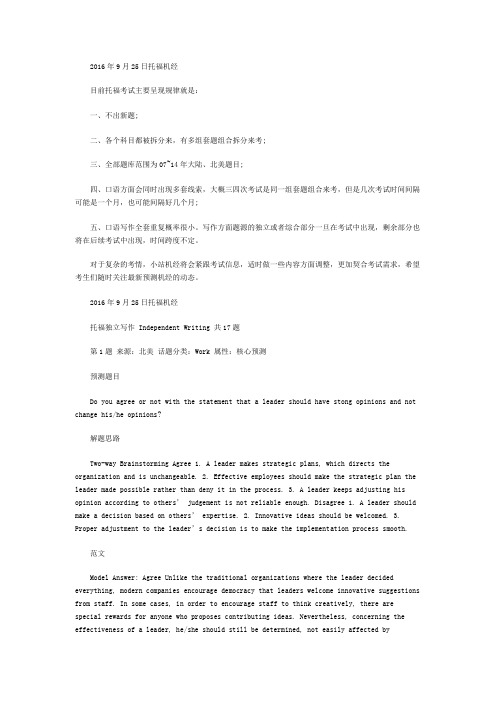
2016年9月25日托福机经目前托福考试主要呈现规律就是:一、不出新题;二、各个科目都被拆分来,有多组套题组合拆分来考;三、全部题库范围为07~14年大陆、北美题目;四、口语方面会同时出现多套线索,大概三四次考试是同一组套题组合来考,但是几次考试时间间隔可能是一个月,也可能间隔好几个月;五、口语写作全套重复概率很小。
写作方面题源的独立或者综合部分一旦在考试中出现,剩余部分也将在后续考试中出现,时间跨度不定。
对于复杂的考情,小站机经将会紧跟考试信息,适时做一些内容方面调整,更加契合考试需求,希望考生们随时关注最新预测机经的动态。
2016年9月25日托福机经托福独立写作 Independent Writing 共17题第1题来源:北美话题分类:Work 属性:核心预测预测题目Do you agree or not with the statement that a leader should have stong opinions and not change his/he opinions?解题思路Two-way Brainstorming Agree 1. A leader makes strategic plans, which directs the organization and is unchangeable. 2. Effective employees should make the strategic plan the leader made possible rather than deny it in the process. 3. A leader keeps adj usting his opinion according to others’ judgement is not reliable enough. Disagree 1. A leader should make a decision based on others’ expertise. 2. Innovative ideas should be welcomed. 3. Proper adjustment to the leader’s decision is to make the implementation process smooth.范文Model Answer: Agree Unlike the traditional organizations where the leader decided everything, modern companies encourage democracy that leaders welcome innovative suggestions from staff. In some cases, in order to encourage staff to think creatively, there are special rewards for anyone who proposes contributing ideas. Nevertheless, concerning the effectiveness of a leader, he/she should still be determined, not easily affected by others’ opinions. To begin with, a leadermakes strategic plans, which directs the organization and is unchangeable. A strategic plan is an organization’s process of defining its strategy, or direction, and making decisions on allocating its resources to pursue this strategy. It may also extend to control mechanisms for guid 登录查看全部内容第2题来源:北美话题分类:Work 属性:核心预测预测题目Do you agree or disagree with the following statement? The most important characteristic to a successful politician or leader is good communication skills.解题思路⌝总观点:对于成功的政治家或是领导者来说,沟通能力并不是最重要的。
不知考啥?0702托福阅读机经奉上
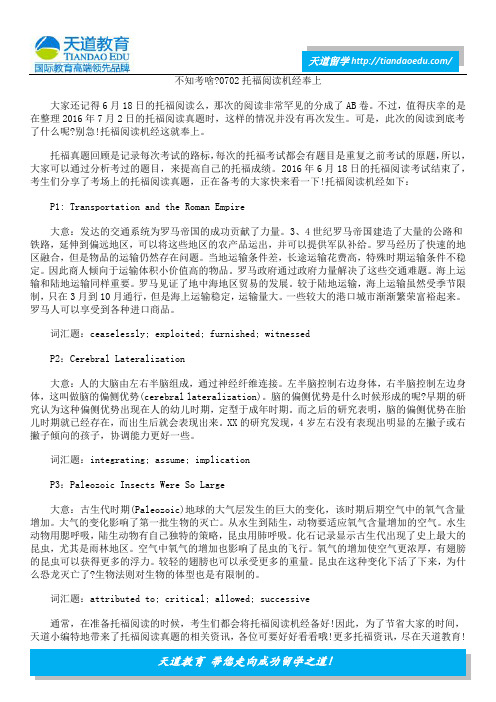
不知考啥?0702托福阅读机经奉上大家还记得6月18日的托福阅读么,那次的阅读非常罕见的分成了AB卷。
不过,值得庆幸的是在整理2016年7月2日的托福阅读真题时,这样的情况并没有再次发生。
可是,此次的阅读到底考了什么呢?别急!托福阅读机经这就奉上。
托福真题回顾是记录每次考试的路标,每次的托福考试都会有题目是重复之前考试的原题,所以,大家可以通过分析考过的题目,来提高自己的托福成绩。
2016年6月18日的托福阅读考试结束了,考生们分享了考场上的托福阅读真题,正在备考的大家快来看一下!托福阅读机经如下:P1: Transportation and the Roman Empire大意:发达的交通系统为罗马帝国的成功贡献了力量。
3、4世纪罗马帝国建造了大量的公路和铁路,延伸到偏远地区,可以将这些地区的农产品运出,并可以提供军队补给。
罗马经历了快速的地区融合,但是物品的运输仍然存在问题。
当地运输条件差,长途运输花费高,特殊时期运输条件不稳定。
因此商人倾向于运输体积小价值高的物品。
罗马政府通过政府力量解决了这些交通难题。
海上运输和陆地运输同样重要。
罗马见证了地中海地区贸易的发展。
较于陆地运输,海上运输虽然受季节限制,只在3月到10月通行,但是海上运输稳定,运输量大。
一些较大的港口城市渐渐繁荣富裕起来。
罗马人可以享受到各种进口商品。
词汇题:ceaselessly; exploited; furnished; witnessedP2:Cerebral Lateralization大意:人的大脑由左右半脑组成,通过神经纤维连接。
左半脑控制右边身体,右半脑控制左边身体,这叫做脑的偏侧优势(cerebral lateralization)。
脑的偏侧优势是什么时候形成的呢?早期的研究认为这种偏侧优势出现在人的幼儿时期,定型于成年时期。
而之后的研究表明,脑的偏侧优势在胎儿时期就已经存在,而出生后就会表现出来。
XX的研究发现,4岁左右没有表现出明显的左撇子或右撇子倾向的孩子,协调能力更好一些。
- 1、下载文档前请自行甄别文档内容的完整性,平台不提供额外的编辑、内容补充、找答案等附加服务。
- 2、"仅部分预览"的文档,不可在线预览部分如存在完整性等问题,可反馈申请退款(可完整预览的文档不适用该条件!)。
- 3、如文档侵犯您的权益,请联系客服反馈,我们会尽快为您处理(人工客服工作时间:9:00-18:30)。
Biology
Poisonous Insects and the Birds that Eat them
7月16日
history
The Rise of Florence
biology
Characteristics of Tropical Rain Forest
biology
Why Nonavian Dinosaur Become Extinct?
8月27日
History
Photography and pictorial weeklies
Magafauna Eቤተ መጻሕፍቲ ባይዱtinction Green Crab
Differences between Ancient Europe Towns and Villages Constraints on Natural Selection The decline of Western Rome Insect senses
Art 12月11日
The Sistine Ceiling
History
Explanation of the Collapse of Bronze Age Societies
biology
12月10日
economy
Geology
Effects of Predation on distribution of species The Age of Industrialism Methane and PETM
History art
Coal, Iron and Steam cinema
biology
The Extinction of the Dinasours
biology
Kelp and the forests
9月10日 (AB卷)
9月3日
Art
biology biology History biology History Biology economy
7月10日
Economy
Currency and the Emergence of China’s Market Economy
biology
Isolation and Diversification in the Tropical Rain Forest
7月9日 7月3日 7月2日
science History biology history history biology History science biology
dating rock art Eli Terry's clock Solnfolen Limestone and Archeopteryx the water and the Mars the prairie formation of the United States Revival of Greece intestate highway of the United States The Advent of Printing
10月29日
Biology
10月28日
Geology Biology Geology biology Geology
10月22日
history
continental drift Development of Agriculture
Cosmic Controversy Food Preservation
Early Photography in the United States
The Cambrian Explosion Adopting Roman Values Transport and American Development Habitat Selecting of Birds How Earth’s Ocean Formed
12月10日 下午
History biology
biology
The collapse of Copan Sauropods skeletal innovation Why Paleozoic Insects were so large
Science 12月3日
The sleep
Science
12月3日
The climate of the past the importance of mail service to the early United States
weak electric system in fish Early Farming in the Colorado Plateau
The Mycenaean Collapse The Insect Senses
characteristics of tropical rain forest small mammals
Parental care by frogs continental drift
11月13日
Geology
history
11月12日
Science
science
Art
11月5日
biology
History History
geology
art
History
10月15日
biology
science
geology
9月25日
history
history
History
9月24日
biology
biology
Art
Pyramid at Saqqara Bee keeping
life in the desert mapping the world
The Tropical mammal The origin of Earth atmosphere Extinction of Cretaceous period
Pleistocene Climate Pyramid at Saqqara
10月22日
history
Biology biology
10月16日
Easter Island’s Statues Primitive and Advanced Termites Species
Birds and Food Storage The Origin of Cinema Postwar Economics
The origin and rise of mordern birds High Middle Age Chaco phenomena
Marsupial Weak Electric Systems In Fish
Cave and rock arts
Art
9月11日
History
Science
Cave and rock arts Towns in the high middle ages
Lighting in museums
9月10日 下午
Transportation and the Roman Empire Cerebral Lateralization
Paleozoic Insects Were So Large
content 先讲亚马逊的土地不适合耕作。后来讲到亚马逊开始发展农业的原因。由于当地人口密集,不能完全靠swindle理论解释, 于是引出了亚马逊农业发达的原因,就是洪水使riverbank沉淀,sediment所以土地非常得fertile;农民有方法来改善土地质 量,往里面添加很多成分以确保土地中营养物质留存;农民们有计划地进行耕作,选择性种植valuable corps,并且把种子
出Warm Theory 认为羽毛维持体温,鸟龙好像是温血动物,能比冷血动物在追捕猎物移动更久。
主要讲了stream和sediment。先说了stream下了定义,然后说水流沉淀的三种方式,分别是solution, suspension和river bed。然后每种都有解释,第一种溶解,水里有各种矿物质什么的。第二种并不是所有东西都溶解,要看particle。小的流速 快跟着河流就走了,大的可能在水里跳就讲到横向水流流速和颗粒质量导致沉淀速度,于是会出现有suspended 的情况。另 外河流的流速和携带沉淀物的能力没有直接的关系,说沉淀物的大小和类型取决于水流的速度 和沉积的速度,第三种bed不 第1段讲了冰川对陆地的影响很大。冰川的重量会使大陆表面下降,当然这个过程很久,要用上很多年。然后地球表面又要 用很久的时间满满恢复原来的高度。比如Husdon和Great lake 现在就在慢慢恢复回上次冰川世纪前的高度。第二段讲到冰 川的成分。第三段讲到冰川的移动,随着冰川size变大,开始缓慢移动,收到重力的影响。移动的过程中,会切割岩石,推 倒树木,摧毁遇到的一切living。第四段讲到在平坦的地方形成的冰川会移动缓慢,朝各个方向发展。而在山谷形成的冰川, 第1段讲到fresco,是将水和颜料混合去完成的一种technique,还会融合plaster。还有一种secco fresco,是在已经干掉的 plaster上上色。第2段讲到Sistine Chapel ceiling,是由Michelangelo著作完成,刚开始他还是很犹豫的。但是开始画以 后,他就开始用最纯粹的fresco的方法画了。整个ceiling他用了四年的时间完成,因为整个工作量很大,所以他用了干比较
distribute创收制造产。
主要讲解了鸟类飞行的起源和羽毛功能研究。全文分四段,先讲发现一种恐龙化石Archaeopteryx,然后研究在鸟可不可以 通过flip来飞行,产生分歧。第二段说其实羽毛最初出现是为了提供剧烈肌肉运动中需要的热能,这为之后飞行提供了基础。 第三段介绍对羽毛的第一种解释,Tree Theory认为鸟龙之前住在树上,热量使它们能够从树间进行远距离移动。第四段提
